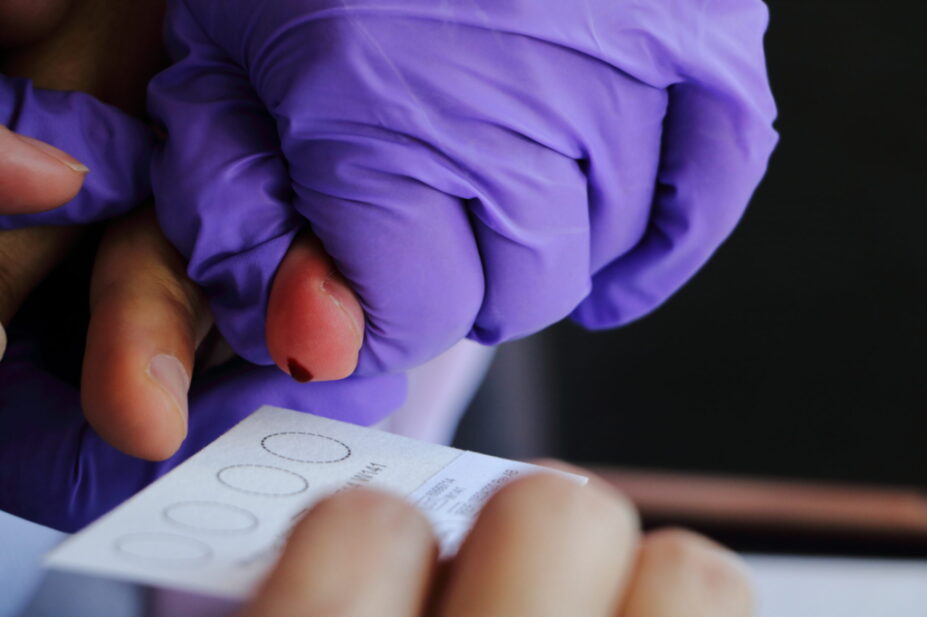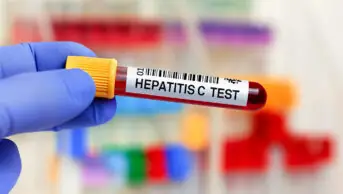
Shutterstock.com
Hepatitis C (HCV) is a blood-borne virus that is most common in people who inject drugs (PWID), owing to transmission of the virus through the sharing of injecting equipment. If untreated, HCV can progress to cirrhosis of the liver and hepatocellular carcinoma (liver cancer), but it can be cured with a course of direct-acting antivirals, which are taken orally for eight or twelve weeks and have minimal contraindications or side effects. Other risk factors for HCV infection include: receiving blood products prior to September 1991; receiving organ or tissue transplants before 1992; use of unsterile needles for tattoos and piercings; medical or dental treatment in areas where HCV is common (including Africa, the Middle East and central Asia); unprotected sex; or vertical transmission — where an infected mother can pass it to their baby during childbirth or in the womb[1].
The World Health Organization (WHO) has a target to eliminate HCV by 2030 and NHS England is on track to meet an earlier date of 2025[2]. To achieve this, easy access to regular testing is imperative. A patient who receives a positive test can then be treated, which prevents them from developing long-term complications of liver disease, as well as onward transmission of the virus (so-called ‘treatment as prevention’). This is especially important in PWID. Once HCV has been eliminated, it is essential that testing remains easily accessible. A modelling study has demonstrated that if testing does not continue after elimination in 2025, the prevalence of HCV will increase. It is estimated that, in the absence of testing or treatment, up to 25% of PWID will be infected with HCV within five years of elimination being achieved[3].
Pharmacists have a strong relationship with their patients, which helps to overcome barriers to testing
In pilot studies, community pharmacies have been found to be effective locations for HCV testing, in both the UK and abroad[4–8]. A pilot study on the Isle of Wight offered dry blood spot testing for HCV to anyone with a risk factor for the virus. The service was closely supported by local hospital services, with clinicians from the local hospital visiting the pharmacies to provide support with conveying positive diagnoses. The service also benefited from an automated referral system, using PharmOutcomes[5,6]. A pilot in Tayside, Scotland, also used dry bloodspot testing and found PWID were significantly more likely to be tested there than in other services they attended[4]. Community pharmacies are a good place to test for HCV because they are accessible to PWID and are situated in communities where the prevalence of HCV is highest — 99% of people living in areas of highest deprivation in England are within a 20-minute walk of a pharmacy[9]. Pharmacists also have a strong relationship with their patients, specifically PWID, which helps to overcome barriers to testing[10]. Box 1 summarises three main reasons why community pharmacies are good locations to test for HCV.
Box 1: Reasons why community pharmacy-based hepatitis C testing has worked in pilot studies
- Community pharmacies are geographically close to populations most at risk of hepatitis C;
- Strong, positive relationships between community pharmacists and people who inject drugs;
- People who inject drugs regularly (often daily) attend community pharmacies.
In 2020, in response to the promise showed in published pilot studies, NHS England (NHSE) commissioned an advanced service to test for HCV in community pharmacies across England[11]. The service was specifically for PWID, who were not engaged with drug and alcohol treatment services.
Six months after the service was commissioned, NHSE sent out a national survey to gauge uptake of the service. The online survey was sent to staff working within operational delivery networks (ODNs) — regional multidisciplinary teams working across primary and secondary care, composed of specialist nurses, hepatologists and pharmacists, which are responsible for managing HCV treatment. The responses from the survey revealed that, despite 95% of ODNs consisting of pharmacies that had registered interest in the service, only 15% reported pharmacies in their area performing any HCV tests[12]. The Pharmaceutical Services Negotiating Committee clinical services dashboard shows that, in early 2021, only seven HCV tests were performed in England as part of the NHSE service[13].
Hepatitis C testing in community pharmacy is a vital intervention to maintain elimination of the virus in England after 2025
HCV testing in community pharmacy is a vital intervention to maintain elimination of the virus in England after 2025. Accordingly, it is important to understand why the NHSE service uptake has been limited and define what an effective and sustainable testing service looks like.
A review of pilot studies that have evaluated HCV testing in community pharmacies highlights differences between these and the NHSE service[14]. The characteristics of a successful service and how this contrasts with the NHSE service are also clear in a recent Delphi consensus exercise that developed a statement (the I-COPTIC statement) defining a blue-print for a successful, sustainable service[14,15].
The I-COPTIC statement was developed with a group of expert participants, including community pharmacists, local pharmaceutical committee chief officers, viral hepatitis specialist nurses, secondary care pharmacists, an academic pharmacist and doctors. All participants were sent a series of three surveys. The responses to the surveys led to 60 agreed individual statements, which were combined to produce the final collaboration statement. There were many themes within the accepted statements and the preliminary results have been presented and are due to be published in full later in 2023. These include pharmacy selection, target population for testing and the set-up of the service, as well as the testing process and action taken upon results. Box 2 includes some examples of the main messages from the I-COPTIC statement[15].
Box 2: Messages from the I-COPTIC statement that describe a blueprint for an effective community pharmacy-based hepatitis C testing service
- All pharmacies should be able to offer hepatitis C (HCV) testing, but pharmacies with good existing relationships with at-risk populations (e.g. those that offer needle syringe programmes and opioid substitution treatment services) should be prioritised;
- The local HCV treatment team should provide testing kits (rather than the pharmacy having to purchase them);
- Pharmacies should have direct contact links with their local HCV treatment team;
- Pharmacies should be reimbursed for time spent in training;
- Pharmacy software should be available to record testing activity;
- Referral should be sent automatically to the local treatment team when a positive result is uploaded[15].
There are some differences between the I-COPTIC statement and the NHSE service. For example, the I-COPTIC statement says that anyone with any risk factor should be able to have a test in a community pharmacy, and that testing should include a polymerase chain reaction test, which confirms current infection. By contract, in the NHSE service, testing was restricted to PWID who were not engaged with drug and alcohol treatment services. In addition, only antibody testing was provided, which shows someone has been exposed to, but does not necessarily still have, the virus. The I-COPTIC collaboration also suggests specific software is used, rather than the paper forms used in the NHSE service, for recording testing activity and results. This information collection should then allow automatic referrals for positive cases to be sent, automatic invoices to be generated and activity summaries to be produced. This thereby significantly reduces the amount of work required by pharmacy staff.
On 1 April 2023, the advanced NHSE service was decommissioned. The I-COPTIC statement was presented directly to NHSE in June 2022 because it is important that: 1) a new service is commissioned and 2) the new service reflects the content of the I-COPTIC statement. It is also very important that the clinical community understands what activity is needed to sustain HCV elimination once NHSE targets are met.
Elimination does not mean the virus has gone completely. Without continued investment in sustainable testing, the prevalence will increase. Community pharmacies are uniquely placed in the care pathway for PWID to continue testing and identify new infections that will arise.
Acknowledgements
- I-COPTIC collaboration (Charlotte Cook, Leila Reid, Stuart Smith, Deborah Crockford, Ahmed M Elsharkawy, Stuart McPherson, Mark Wright, Andrew Radley, Hassan Malik, Sandie Keall, Janet Catt, Sital Shah, Helen Hampton, Julia Powell, Danny Morris, Helen Boothman, John Dillon, Martin Read, Paul Selby, James Spear, Andrew Ustianowski, Paul John, Vasileios Alafodimos, Ryan Buchanan)
- Salim I Khakoo
- Julie Parkes
- The Hepatitis C Trust
- 1Diagnosis – Hepatitis C. NHS. https://www.nhs.uk/conditions/hepatitis-c/diagnosis/ (accessed 24 Apr 2023).
- 2Global health sector strategy on viral hepatitis 2016-2021. Towards ending viral hepatitis. World Health Organization. 2016.https://apps.who.int/iris/handle/10665/246177 (accessed 24 Apr 2023).
- 3Siegele‐Brown C, Siegele‐Brown M, Cook C, et al. Testing to sustain hepatitis C elimination targets in people who inject drugs: A network‐based model. Journal of Viral Hepatitis. 2023;30:242–9. doi:10.1111/jvh.13786
- 4Radley A, Melville K, Tait J, et al. A quasi-experimental evaluation of dried blood spot testing through community pharmacies in the Tayside region of Scotland. Frontline Gastroenterol. 2017;8:221–8. doi:10.1136/flgastro-2016-100776
- 5Buchanan R, Cooper K, Grellier L, et al. The testing of people with any risk factor for hepatitis C in community pharmacies is cost‐effective. J Viral Hepat. 2019;27:36–44. doi:10.1111/jvh.13207
- 6Integrating community pharmacy testing for hepatitis C with specialist care. Pharmaceutical Journal. 2016. doi:10.1211/pj.2016.20201549
- 7Kugelmas M, Pedicone L, Lio I, et al. Hepatitis C Point-of-Care Screening in Retail Pharmacies in the United States. Gastroenterol Hepatol (N Y) 2017;13:98–104.https://www.ncbi.nlm.nih.gov/pubmed/28450816
- 8Gauld N, Perry J, Jackson C, et al. Feasibility and outcomes of a hepatitis C screening programme in community pharmacies. N Z Med J 2020;133:74–83.https://www.ncbi.nlm.nih.gov/pubmed/33223550
- 9Todd A, Copeland A, Husband A, et al. The positive pharmacy care law: an area-level analysis of the relationship between community pharmacy distribution, urbanity and social deprivation in England. BMJ Open. 2014;4:e005764–e005764. doi:10.1136/bmjopen-2014-005764
- 10Radley A, Melville K, Easton P, et al. ‘Standing Outside the Junkie Door’—service users’ experiences of using community pharmacies to access treatment for opioid dependency. Journal of Public Health. 2016;39:846–55. doi:10.1093/pubmed/fdw138
- 11Service specification: Community pharmacy Hepatitis C Antibody Testing Service – Advanced Service. NHS England. 2020.https://www.england.nhs.uk/publication/service-specification-community-pharmacy-hepatitis-c-antibody-testing-service-advanced-service/ (accessed 24 Apr 2023).
- 12Cook C, Reid L, Smith S, et al. P031 The implementation of the national health service England service for hepatitis C antibody testing in community pharmacies: a national survey of hepatitis C operational delivery networks. Posters. 2021. doi:10.1136/gutjnl-2021-basl.40
- 13Clinical services statistics. The Pharmaceutical Services Negotiating Committee. 2021.https://psnc.org.uk/funding-and-reimbursement/nhs-statistics/clinical-services-statistics/ (accessed 24 Apr 2023).
- 14Cook C, Reid L, et al. I-COPTIC: Implementation of community pharmacy-based testing for hepatitis C: Delphi consensus protocol. International Journal of Pharmacy Practice. 2022;30:541–7. doi:10.1093/ijpp/riac064
- 15Cook C, Reid L, Smith S, et al. P79 Optimising the Implementation of Community Pharmacy Based testing for Hepatitis C: Delphi consensus statement. Abstracts. 2022. doi:10.1136/gutjnl-2022-basl.130


